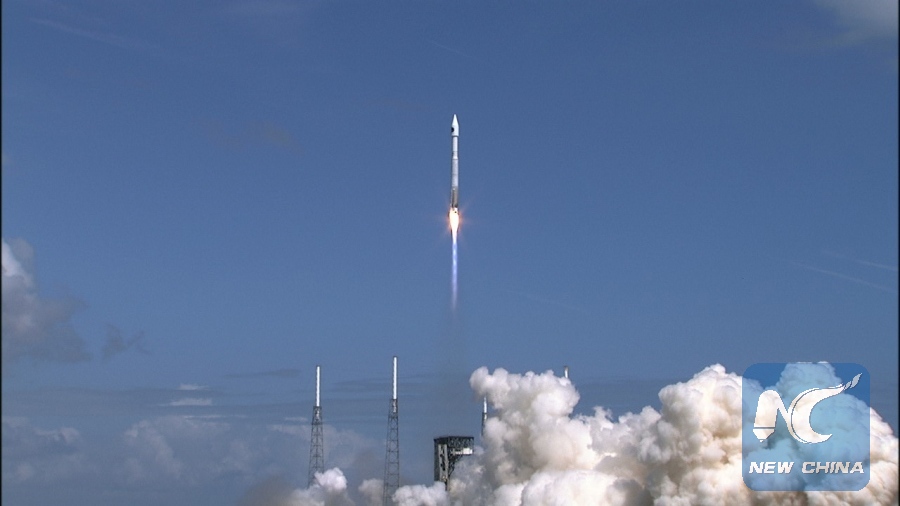
Orbital ATK's seventh cargo delivery flight to the International Space Station launched at 11:11 a.m. EDT April 18, 2017, on a United Launch Alliance Atlas V rocket from Space Launch Complex 41 on Cape Canaveral Air Force Station in Florida. (Credits: NASA TV)
WASHINGTON, April 18 (Xinhua) -- Orbital ATK's unmanned cargo ship blasted off Tuesday for its seventh resupply mission to the International Space Station.
The Cygnus spacecraft, named after former U.S. astronaut John Glenn, took off atop a United Launch Alliance (ULA) Atlas V rocket at 11:11 a.m. EDT (1511 GMT) from Cape Canaveral Air Force Station in Florida.
"Liftoff of the Atlas V rocket with Cygnus and the S.S. John Glenn, extending the research legacy for living and working in space," a NASA TV commentator said during a live broadcast.
Glenn was the first American to orbit the Earth. He died last December at age 95.
MORE CARGO
Cygnus is carrying more than 7,600 pounds (3,400 kilograms) of cargo to the orbital laboratory, including crew supplies, hardware, scientific experiments and 38 CubeSats that will be deployed from either the spacecraft or space station in the coming months.
"We are carrying more this time than we have in the past and that's a good step forward for us and for the crew," Frank Culbertson, president of Orbital ATK's Space Systems Group, told reporters during a pre-launch news conference.
"The more research we can carry, the more they can do their job and the more they can show the utility of the International Space Station."
According to the U.S. space agency NASA, the new experiments include an antibody investigation that could increase the effectiveness of chemotherapy drugs for cancer treatment and an advanced plant habitat for studying plant physiology and growth of fresh food in space.
Another new investigation bound for the space station's U.S. National Laboratory will look at using magnetized cells and tools to make it easier to handle cells and cultures, and improve the reproducibility of experiments.
If everything goes well, the spacecraft will arrive at the space station on April 22 and will stay there until July, when it will depart with several tons of trash for a fiery reentry into Earth's atmosphere.
Prior to re-entry, a third and final experiment will be conducted inside the spacecraft to study how fire burns in space. The first two space fire experiments took place during previous Cygnus resupply missions.
360-DEGREE VIEW
Tuesday's launch marked the first time NASA, in coordination with the ULA and Orbital ATK, has broadcast a rocket launch with a 360-degree view, which should "virtually place the public at the base of the rocket during launch."
But the live 360 stream appeared to completely miss the actual launch itself, with viewers seeing the rocket on the ground a second ago and then a red spot high in the sky.
NASA confirmed that many viewers experienced "technical difficulties" with the live feed.
"Live 360-degree is an emerging technology," the U.S. space agency said in a statement. "This is the first time that this has ever been attempted and ... we will review today's 360-degree setup and endeavor to bring this new perspective of a rocket launch to everyone in the future."
The launch of the cargo ship has been delayed several times over the past month due to hydraulic leaks on the rocket booster and ground support equipment.
"We are sorry we missed Easter," said Culbertson, a former NASA astronaut, "but we're pretty sure they'll be excited about their Easter baskets and whatever great things International Space Station science put on board for them."

